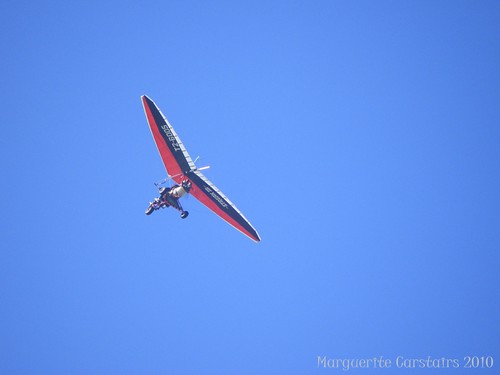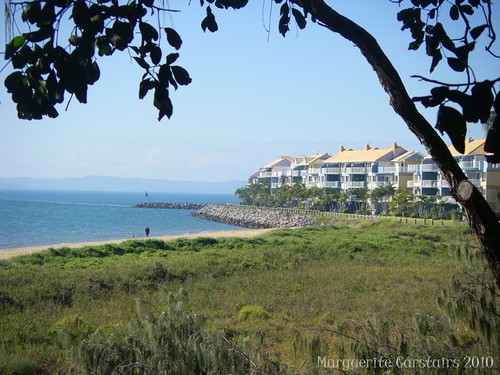
New artwork now graces a Hervey Bay site that Fraser Coast inhabitants have regarded as "one of the best places in the world" for thousands of years. The artwork includes a shelter, two seats and designs embedded into a decorative concrete pad.
The artwork was by local Butchulla people. Those involved included artists Shawn Wondunna-Foley, Jan Williams, Shirley Blake, Annette Broome, Shortea Broome, Deleece Henderson and the Scrub Hill community with Auntie Francis as the overseeing Elder.
http://www.arts.qld.gov.au/funding/dayman-park.html

Hervey Bay is a well-frequented holiday destination, a huge retirement centre, and the most popular access point to Fraser Island. Essentially a string of associated villages - Urangan, Torquay, Scarness, Pialba and Point Vernon - it stretches along the bay in a series of small shopping centres and a seemingly endless run of holiday units, motels, caravan parks and flats.
Located 300 km north of Brisbane and 37 km east of Maryborough, Hervey Bay's great attraction lies in the diversity it offers - whale spotting, fishing, walking, water skiing, scuba diving, fishing, exploring nearby Fraser Island. There is a bird sanctuary and an aquarium. There is also an interesting and substantial historical museum and a memorial to the kanakas who worked the sugar fields in the area.
Hervey Bay has had little respect for its past. Once a series of quiet and sleepy villages it is now in the process of exploding into a Gold Coast style series of holiday destinations. It is now a city (officially proclaimed in 1984) encompassing a series of small villages, all of which now blend together. With this development has come the inevitable problem that much of the character of the area has been sacrificed by the construction of modern project homes for people (apparently most of them came from Victoria) eager to retire to the sun. This problem is compounded by the fact that much of the beach foreshore is taken up with Caravan Parks (it actually boasts that it is the 'Caravan Capital of Australia') creating a very one dimensional feel about the place - shops on one side of the Esplanade, then Caravan Parks, then a narrow hard sand beach.
The first European to reach the Hervey Bay area was Captain James Cook who sailed past Fraser Island naming many of the prominent features. Cook did not sail into Hervey Bay. In fact he was some 6 km offshore as he sailed north. This did not stop him naming the bay after the 'English Casanova', Augustus John Hervey, a sailor of some note who acquired a fierce reputation as a womaniser.
Matthew Flinders passed through the area twice. In 1799, Flinders sailed around Fraser Island entering the bay and going ashore at the present site of Dayman Park. He was the first European to step ashore at Hervey Bay.
It is one of the ironies of history that Flinders, who returned to the area in 1802 on his historic circumnavigation of the Australia, did not located the Fraser Island Straits on either of his voyages.
The first settlement of Hervey Bay occurred in the 1850s. Hervey Bay was originally part of a cattle station, the Toogoom Run, which was settled in 1854. The first permanent white settler at Hervey Bay was Boyle Martin who, with his wife and child, arrived in 1863. He worked cutting timber and it is suggested that he was the first person to grow sugar cane in the area. By 1859 the first subdivision of land around Hervey Bay took place.
The attractions of the area were obvious. The fishing was good, the place was quiet, the weather was excellent, the area around the bay was flat and accessible. All these factors quickly led Maryborough businessmen to take up large waterfront blocks of land for weekend retreats.
In the 1870s many Scandanavian settlers moved into the area and for a short time Hervey Bay became known as Aarlborg. At this time the area was basically used for dairy farming.
In the 1880s sugar was introduced to the area and the Kanakas were brought from the South Pacific islands to work on the sugar plantations.
In 1896 the Bay was connected to Maryborough by railway and in 1917 (progress wasn't exactly rapid) the Urangan Pier was completed and Urangan became an important port for the export of sugar.
Modern tourism started in the 1950s when Hervey Bay became a popular retreat particularly for retired Victorians who were initially attracted to the area by the warmth of the climate and later the added appeal of 'no death duties'. It has continued to grow in popularity so that in 1984 Hervey Bay was proclaimed a city.
http://www.smh.com.au/news/Queensland/Hervey-Bay/2005/02/17/1108500203391.html
140x45.jpg)




No comments:
Post a Comment